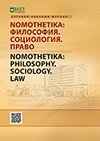Regulation of external labor migration in the USSR during the new economic policy and in the Russian Federation at the present stage of market relations formation: historical and legal parallels
DOI:
https://doi.org/10.18413/2712-746X-2020-45-3-504-515Keywords:
national labor market, migration policy, labor migration, labor migrant, foreign labor force, foreign specialist, emigration, immigration, re-emigration, voluntary relocation of compatriotsAbstract
The review of the development of the state's legal system and the issue of legal succession in similar areas of legal regulation allow us to reveal General patterns in the history of the formation of the oretical or philosophical nature. At the same time, it is the analysis of succession in specific areas of legal regulation that allows us to identify the General principles of this process. In this regard, the authors conducted a comparative analysis of the state-legal regulation of labor migration during the NEP and at the present stage of the construction of market relations in the Russian Federation, on the basis of which a number of conclusions were made. First, the state systems of regulating labor immigration in the RSFSR (USSR) in the early 1920s and in the Russian Federation in the 90s of the twentieth century were formed under the influence of external and internal factors. Secondly, the state regulation of labor migration in both periods combined the principles of centralization, unity of command and interdepartmental collegiality. Third, both the Soviet state in the 20s of the last century, and the Russian Federation from the 90s of the twentieth century to the present time, are making great efforts to attract their former compatriots to the country. These measures had not only economic, but also great political significance for both States. The research made it possible to identify General patterns of formation of a legal mechanism for regulating labor migration on the territory of the Russian state at different historical stages of its development, but in similar socio-economic conditions. The results of this research in the context of conducting a comprehensive study of historical and legal succession are of interest for a more complete study of the history of state construction and law in Russia.
Downloads
References
Богданов С.В., Кучеренко М.И. 2014. Причины деформации рынка труда в Советской России периода НЭПА. Научные ведомости Белгородского государственного университета, 1: 142–149.
Волков Е.З. 1930. Динамика населения за 80 лет. М., 271 с.
Галлас М.Л. 2011. Государственный механизм регулирования трудовой иммиграции и реэмиграции в СССР в 1920-е гг. Власть, 3: 139–146.
Ермушин М.В., Беляев Г.В. 2016. Советская политика по оплате труда иностранных инженеров в 20-е гг. XX века. Вестник КГУ им. Н.А. Некрасова, 1: 39–41.
Зайончковская Ж.А. 2000. Миграция населения СССР и России в XX веке: эволюция сквозь катаклизмы. Проблемы прогнозирования, 4: 3–6.
Ипполитов С.С. 2004. Российская эмиграция и Европа: несостоявшийся альянс. М., 367 с.
Ледяев Д. 1927. Безработица в СССР и борьба с ней (1917–1927 гг.). Вопросы труда. 10: 109 с.
Моисеенко В.М. 2017. Международная миграция в России (СССР) в конце XIX –первой трети XX. Часть третья: Международная миграция в СССР в 1923–1930 гг. Демографическое обозрение. 2(4): 122–123.
Моисеенко В.М. 2016. Эмиграция и иммиграция в РСФСР (СССР) в 1920-е гг. Миграция и социально-экономическое развитие. Т. 1. 1: 63–78.
Полян П.М. 2001. Не по своей воле. История и география принудительных миграций. М.: ОГИ. 326 с.
Тюркин М.Л. 2009. Миграционная политика Российской Федерации. Опыт и перспективы развития. М., 366 с.
Урланис Б.Ц. 1968. Динамика населения СССР за 50 лет. Население и народное благосостояние. М.
Kornyushkina A.Y., Markhgeym M.V., Novikova A.E., Doronina O.N., Zajcev S.Y. 2017. Minimization of human rights risks: the constitutional legal experience of post-soviet states. Turkish online journal of design art and communication. Vol. 7, № S-APRLSPCL: 352–356.
Makogon B.V., Markhgeym M.V., Minasyan A.A., Novikova A.E., Yarychev N.U. 2019. Logical classification of legal procedural restrictions. Revista Inclusiones. Vol. 6. 2-5: 395–401.
Makogon B.V., Savel’eva I.V., Lyahkova A.I., Parshina A.A., Emel’anov A.S. 2017. Interpretation of legal responsibility as a universal instrument of procedural legal restrictions. The Turkish Online Journal of Design Art and Communication. Vol. 7. № S-APRLSPCL: 328–332.
Abstract views: 686
Share
Published
How to Cite
Issue
Section
Copyright (c) 2020 NOMOTHETIKA: Philosophy. Sociology. Law

This work is licensed under a Creative Commons Attribution 4.0 International License.


